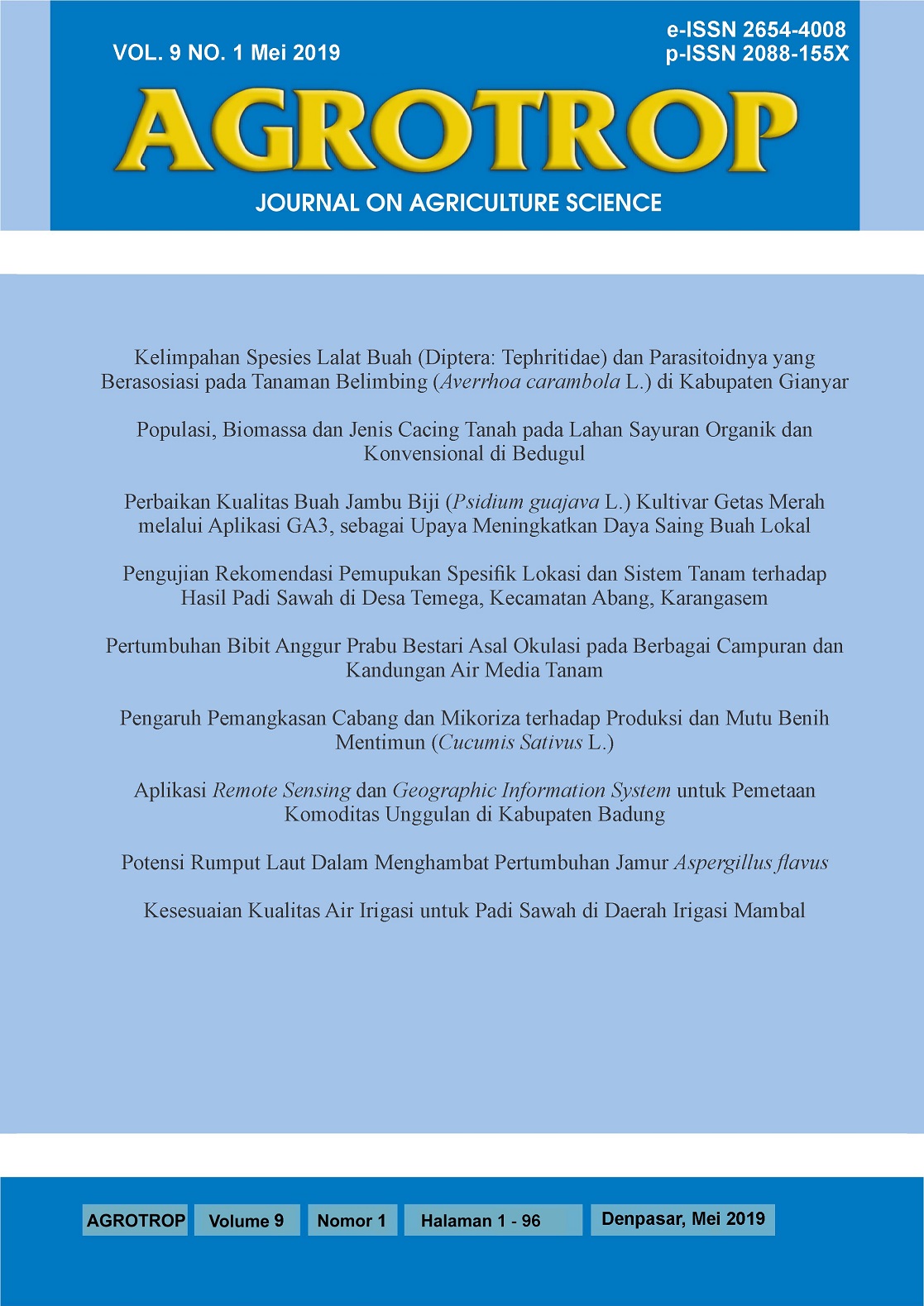Populasi, Biomassa dan Jenis Cacing Tanah pada Lahan Sayuran Organik dan Konvensional di Bedugul
Abstract
Population, Biomass, and Types of Earthworm on Organic and Conventional Vegetable Land in Bedugul. Earthworm is an important indicator of soil fertility. The type of earthworm closelly associated with soil management system. This research aims to determine the population, biomass, and earthworms type that had been done on organic and conventional vegetable ecosystem in Bedugul from December 2017 until March 2018. The purposive research sites were located in Baturiti Village and Candikuning Village for organic and conventional vegetable systems, respectively. The research area was clustered following Randomized Block Design into three group sites and devided based on organic and conventional system as the first factor. The second factor was soil depth (0-10, 10-20 and 20-30 cm) that nested on cultivation system. Calculation of collected earthworm was done in situ while their morphological identification was done at The Soil Science and Environment Laboratory, Faculty of Agriculture,Udayana University.The results confirmed that earthworm population and biomass were affected by cultivation system but the values were not significantly difference among soil depths. The population and biomass of earthworm found in organic soils were two times higher than those in conventional land. Earthworms population in organic field ranged from 66.67 to 89.33 m-2 and on conventional land ranged from 16.00-45.33 m-2. The weight of earthworm biomass on organic land ranged from 1.00-1.93 g and on conventional land ranged from 0.03-0.06 g. The type of worm acquired on organic soil was Lumbricus terrestris and on conventional land was Pontoscolex corethrurus. We can summary from this research that cultivation systems highly influence the community of earthworm.
Downloads
References
Curry,J.P., 1994. Grassland Invertebrates. Chapmann & Hall, London, 437p
Dwiastuti Sri & Suntoro. 2009. Eksistensi Cacing Tanah Pada Lingkungan Berbagai Sistem Budidaya Tanaman Di Lahan Berkapur.Universitas Sebelas Maret, Jl. Ir.Sutami No. 36A, Surakarta.
Edward, C.A & P.J. Bohlen. 1996. Biology and Ecology of Earthworms.London: Chapman and Hall.
Jayanthi, Sri, Retno Widhiastuti, Erni Jumilawaty. 2014. Komposisi Komunitas Cacing Tanah Pada Lahan Pertanian Organik Dan Konvensional Di Desa Raya Kecamatan Berastagi Kabupaten Karo. Pascasarjana Departemen Biologi FMIPA Universitas Sumatera Utara.
Kartasapoetra., A.G, Mulyani Sutedjo. 1987. Teknologi Konservasi Tanah dan Air.Cetakan ke dua.Jakarta : Bina Aksara.
Köhler, Anna-Sophie, Sebastian Wolfrum, Julia Huber, Kürt-Jurgen Hüsbergen. 2014. Earthworm abundance and species richness: contribution of farming system and habitat type. Rahmann G &Aksoy U (Eds.). Proc. of the 4th ISOFAR Scientific Conference. ‘Building Organic Bridges’, at the Organic World Congress 2014, 13-15 Oct., Istanbul, Turkey (eprint ID 23992)
Levy PE, Hale SE, and Nicoll BC.2004. Biomass expansion factors and root:shootratios for coniferous tree species in Great Britain. Forestry, 77(5:421-430.
Nuril, H, B. Paul Naiola, E. Sambas, F.Syarif, M. sudiana, J.S.Rahajoe, Suciatmih,T.Juhaeti& Y. Suhardjono. 1999. Perubahan Bioekofisik LahanBekasPenambangan Emas di Jampang dan Metoda Pendekatannya untuk upaya reklamasi. Laporan teknik Proyek Penelitian Pengembangan dan Pendayagunaan Potensi Wilayah, tahun 1998/1999. PuslitbangBiologi LIPI.
Puslittanak.2004. Petunjuk Teknis Pengamatan Tanah.Penerbit Pusat Penelitian Tanah dan Pengembangan Tanah dan Agroklimat. Bogor.
Rombke, J., M.V.Garvia, A. Scheffezy. 2007. Effect of the fungicide benomyl on earthworms inlaboratory tests under tropical and temperate conditions. Arch.Environ Contam oxicol 53, 590-598.
Smetak, K. M., J. L. Johnson-Maynard dan J. E. Lloyd. 2007. Earthworm population density and diversity in different aged urban systems. Applied Soil Eco- logy 37: 161-168.
Subin Kalu, Madan Koirala& Udhab Raj Khadaka.2015. Earthworm population in relation to different land use and soil characteristics.Central Department of Environmental Science, Tribhuvan University, Kirtipur, Kathmandu Nepal.Amrit Science Campus, Tribhuvan University,Thamel, Kathmandu, Nepal.
Tiwari, S. C. 1993. Effect of Organic Manure and NPK Fertilization of Eartworm Activity in an Oxisol.Biology and Fertility ofSoil. 16: 293-295.
Werdhyastuti, N.L. 2018. Sensitivitas Cacing Tanah Lokal di Kecamatan Baturiti terhadap Pupuk Organik dan Pestisida Sintetik.Skripsi.Belum dipublikasikan.
Wijayanti, L. 2007. Kelimpahan Cacing Tanah Pada Tanah Sawah Sistem Budidaya Pertanian Padi Organik dan Anorganik. Skripsi. Jurusan Pendidikan Biologi FMIPA UNY.
Yuliprianto, H. 2009. Prosiding Seminar Nasional Penelitian,Pendidikan dan Penerapan MIPA, Pendidikan Biologi, Fakultas MIPA, Universitas Negeri Yogyakarta.











